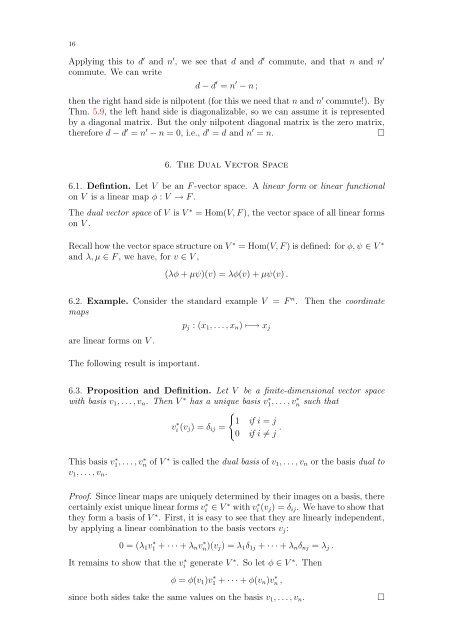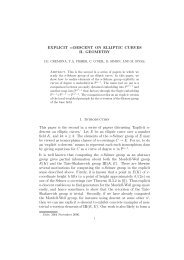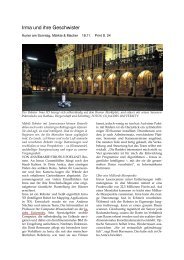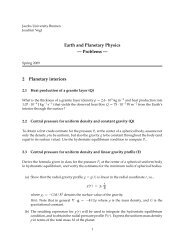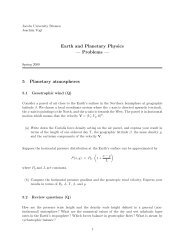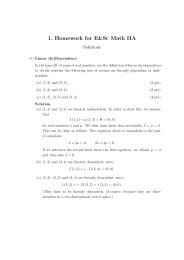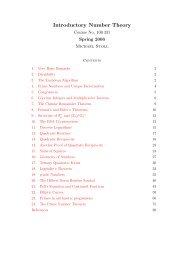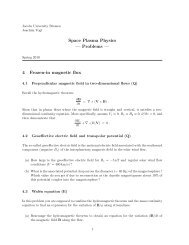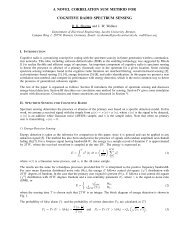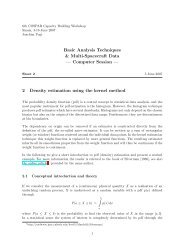Linear Algebra II (pdf, 500 kB)
Linear Algebra II (pdf, 500 kB)
Linear Algebra II (pdf, 500 kB)
Create successful ePaper yourself
Turn your PDF publications into a flip-book with our unique Google optimized e-Paper software.
16<br />
Applying this to d ′ and n ′ , we see that d and d ′ commute, and that n and n ′<br />
commute. We can write<br />
d − d ′ = n ′ − n ;<br />
then the right hand side is nilpotent (for this we need that n and n ′ commute!). By<br />
Thm. 5.9, the left hand side is diagonalizable, so we can assume it is represented<br />
by a diagonal matrix. But the only nilpotent diagonal matrix is the zero matrix,<br />
therefore d − d ′ = n ′ − n = 0, i.e., d ′ = d and n ′ = n. <br />
6. The Dual Vector Space<br />
6.1. Defintion. Let V be an F -vector space. A linear form or linear functional<br />
on V is a linear map φ : V → F .<br />
The dual vector space of V is V ∗ = Hom(V, F ), the vector space of all linear forms<br />
on V .<br />
Recall how the vector space structure on V ∗ = Hom(V, F ) is defined: for φ, ψ ∈ V ∗<br />
and λ, µ ∈ F , we have, for v ∈ V ,<br />
(λφ + µψ)(v) = λφ(v) + µψ(v) .<br />
6.2. Example. Consider the standard example V = F n . Then the coordinate<br />
maps<br />
are linear forms on V .<br />
The following result is important.<br />
pj : (x1, . . . , xn) ↦−→ xj<br />
6.3. Proposition and Definition. Let V be a finite-dimensional vector space<br />
with basis v1, . . . , vn. Then V ∗ has a unique basis v∗ 1, . . . , v∗ n such that<br />
v ∗ <br />
1 if i = j<br />
i (vj) = δij =<br />
0 if i = j .<br />
This basis v ∗ 1, . . . , v ∗ n of V ∗ is called the dual basis of v1, . . . , vn or the basis dual to<br />
v1, . . . , vn.<br />
Proof. Since linear maps are uniquely determined by their images on a basis, there<br />
certainly exist unique linear forms v ∗ i ∈ V ∗ with v ∗ i (vj) = δij. We have to show that<br />
they form a basis of V ∗ . First, it is easy to see that they are linearly independent,<br />
by applying a linear combination to the basis vectors vj:<br />
0 = (λ1v ∗ 1 + · · · + λnv ∗ n)(vj) = λ1δ1j + · · · + λnδnj = λj .<br />
It remains to show that the v ∗ i generate V ∗ . So let φ ∈ V ∗ . Then<br />
φ = φ(v1)v ∗ 1 + · · · + φ(vn)v ∗ n ,<br />
since both sides take the same values on the basis v1, . . . , vn.


